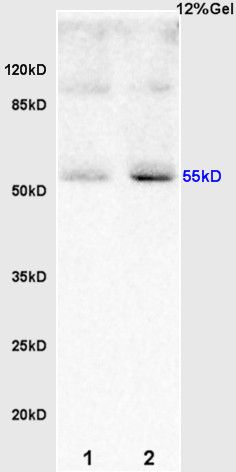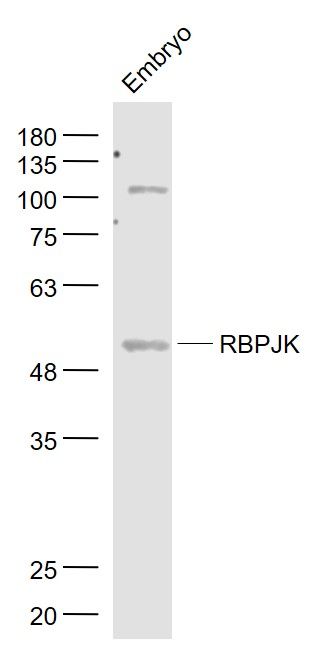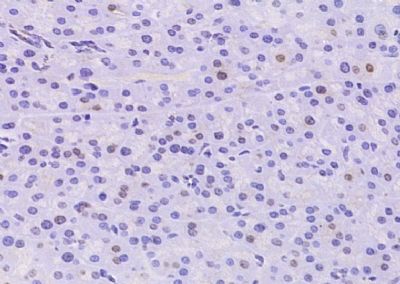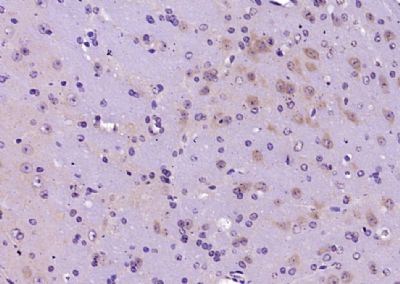| 中文名称 | Notch转录调控蛋白RBPJK抗体 |
| 别 名 | AI843960; CBF 1; CBF-1; CBF1; IGKJRB1; J kappa recombination signal binding protein; J kappa-recombination signal binding protein; J kappa-recombination signal-binding protein; KBF2; NY REN 30 antigen; RBP J kappa; RBP-J; RBP-J kappa; RBP-JK; Rbpj; RBPJK; RBPSUH; Recombining binding protein suppressor of hairless; Renal carcinoma antigen NY-REN-30; SUH_HUMAN. |
| 研究领域 | 染色质和核信号 神经生物学 信号转导 干细胞 转录调节因子 表观遗传学 |
| 抗体来源 | Rabbit |
| 克隆类型 | Polyclonal |
| 交叉反应 | Human, Mouse, (predicted: Rat, Dog, Pig, Cow, Horse, Rabbit, ) |
| 产品应用 | WB=1:500-2000 ELISA=1:500-1000 IHC-P=1:100-500 IHC-F=1:100-500 IF=1:100-500 (石蜡切片需做抗原修复) not yet tested in other applications. optimal dilutions/concentrations should be determined by the end user. |
| 分 子 量 | 56kDa |
| 细胞定位 | 细胞核 细胞浆 |
| 性 状 | Liquid |
| 浓 度 | 1mg/ml |
| 免 疫 原 | KLH conjugated synthetic peptide derived from human RBPJK:101-200/500 |
| 亚 型 | IgG |
| 纯化方法 | affinity purified by Protein A |
| 储 存 液 | 0.01M TBS(pH7.4) with 1% BSA, 0.03% Proclin300 and 50% Glycerol. |
| 保存条件 | Shipped at 4℃. Store at -20 °C for one year. Avoid repeated freeze/thaw cycles. |
| PubMed | PubMed |
| 产品介绍 | Transcriptional regulator that plays a central role in Notch signaling, a signaling pathway involved in cell-cell communication that regulates a broad spectrum of cell-fate determinations. Acts as a transcriptional repressor when it is not associated with Notch proteins. When associated with some NICD product of Notch proteins (Notch intracellular domain), it acts as a transcriptional activator that activates transcription of Notch target genes. Probably represses or activates transcription via the recruitment of chromatin remodeling complexes containing histone deacetylase or histone acetylase proteins, respectively. Specifically binds to the immunoglobulin kappa-type J segment recombination signal sequence. Function: Transcriptional regulator that plays a central role in Notch signaling, a signaling pathway involved in cell-cell communication that regulates a broad spectrum of cell-fate determinations. Acts as a transcriptional repressor when it is not associated with Notch proteins. When associated with some NICD product of Notch proteins (Notch intracellular domain), it acts as a transcriptional activator that activates transcription of Notch target genes. Probably represses or activates transcription via the recruitment of chromatin remodeling complexes containing histone deacetylase or histone acetylase proteins, respectively. Specifically binds to the immunoglobulin kappa-type J segment recombination signal sequence. Binds specifically to methylated DNA. Subunit: Interacts with activated NOTCH1, NOTCH2 or NOTCH3. Interacts with MINT/SHARP. This interaction may mediate the recruitment of large corepressor complexes containing proteins such as HDAC1, HDAC2, NCOR2, SAP30, FHL1/KYOT2 and CIR1. Interacts with EP300, MAML1 and PTF1A. Interacts with Epstein-Barr virus EBNA2, EBNA3, EBNA4 and EBNA6. Interacts with RITA/C12orf52, leading to nuclear export, prevent the interaction between RBPJ and NICD product and subsequent down-regulation of the Notch signaling pathway. Interacts with SNW1. Subcellular Location: Nucleus. Cytoplasm. Note=Mainly nuclear, upon interaction with RITA/C12orf52, translocates to the cytoplasm, down-regulating the Notch signaling pathway. DISEASE: Adams-Oliver syndrome 3 (AOS3) [MIM:614814]: An autosomal dominant form of Adams-Oliver syndrome, a disorder characterized by the congenital absence of skin (aplasia cutis congenita) in combination with transverse limb defects. Aplasia cutis congenita can be located anywhere on the body, but in the vast majority of the cases, it is present on the posterior parietal region where it is often associated with an underlying defect of the parietal bones. Limb abnormalities are typically limb truncation defects affecting the distal phalanges or entire digits (true ectrodactyly). Only rarely, metatarsals/metacarpals or more proximal limb structures are also affected. Apart from transverse limb defects, syndactyly, most commonly of second and third toes, can also be observed. The clinical features are highly variable and can also include cardiovascular malformations, brain abnormalities and vascular defects such as cutis marmorata and dilated scalp veins. AOS3 patients manifest characteristic vertex scalp defects and terminal limb defects, but without congenital heart defects, other associated defects, or immune defects. Note=The disease is caused by mutations affecting the gene represented in this entry. Similarity: Belongs to the Su(H) family. Contains 1 IPT/TIG domain. SWISS: Q06330 Gene ID: 3516 Database links: UniProtKB/Swiss-Prot: Q06330.3 Important Note: This product as supplied is intended for research use only, not for use in human, therapeutic or diagnostic applications. |
| 产品图片 |  Sample: Sample:Embryo (Mouse) Lysate at 40 ug Colon carcinoma (Human) Lysate at 40 ug Primary: Anti-RBPJK (bs-2966R) at 1/300 dilution Secondary: HRP conjugated Goat-Anti-rabbit IgG (bs-0295G-HRP) at 1/5000 dilution Predicted band size: 56 kD Observed band size: 55 kD bs-2966R RBPJK/RBP-J (55kD)  Sample: Sample:Embryo (Mouse) Lysate at 40 ug Primary: Anti- RBPJK (bs-2966R) at 1/1000 dilution Secondary: IRDye800CW Goat Anti-Rabbit IgG at 1/20000 dilution Predicted band size: 56 kD Observed band size: 56 kD  Paraformaldehyde-fixed, paraffin embedded (mouse pancreas tissue); Antigen retrieval by boiling in sodium citrate buffer (pH6.0) for 15min; Block endogenous peroxidase by 3% hydrogen peroxide for 20 minutes; Blocking buffer (normal goat serum) at 37°C for 30min; Antibody incubation with (RBPJK) Polyclonal Antibody, Unconjugated (bs-2966R) at 1:400 overnight at 4°C, followed by operating according to SP Kit(Rabbit) (sp-0023) instructionsand DAB staining. Paraformaldehyde-fixed, paraffin embedded (mouse pancreas tissue); Antigen retrieval by boiling in sodium citrate buffer (pH6.0) for 15min; Block endogenous peroxidase by 3% hydrogen peroxide for 20 minutes; Blocking buffer (normal goat serum) at 37°C for 30min; Antibody incubation with (RBPJK) Polyclonal Antibody, Unconjugated (bs-2966R) at 1:400 overnight at 4°C, followed by operating according to SP Kit(Rabbit) (sp-0023) instructionsand DAB staining. Paraformaldehyde-fixed, paraffin embedded (mouse brain tissue); Antigen retrieval by boiling in sodium citrate buffer (pH6.0) for 15min; Block endogenous peroxidase by 3% hydrogen peroxide for 20 minutes; Blocking buffer (normal goat serum) at 37°C for 30min; Antibody incubation with (RBPJK) Polyclonal Antibody, Unconjugated (bs-2966R) at 1:400 overnight at 4°C, followed by operating according to SP Kit(Rabbit) (sp-0023) instructionsand DAB staining. Paraformaldehyde-fixed, paraffin embedded (mouse brain tissue); Antigen retrieval by boiling in sodium citrate buffer (pH6.0) for 15min; Block endogenous peroxidase by 3% hydrogen peroxide for 20 minutes; Blocking buffer (normal goat serum) at 37°C for 30min; Antibody incubation with (RBPJK) Polyclonal Antibody, Unconjugated (bs-2966R) at 1:400 overnight at 4°C, followed by operating according to SP Kit(Rabbit) (sp-0023) instructionsand DAB staining. |
